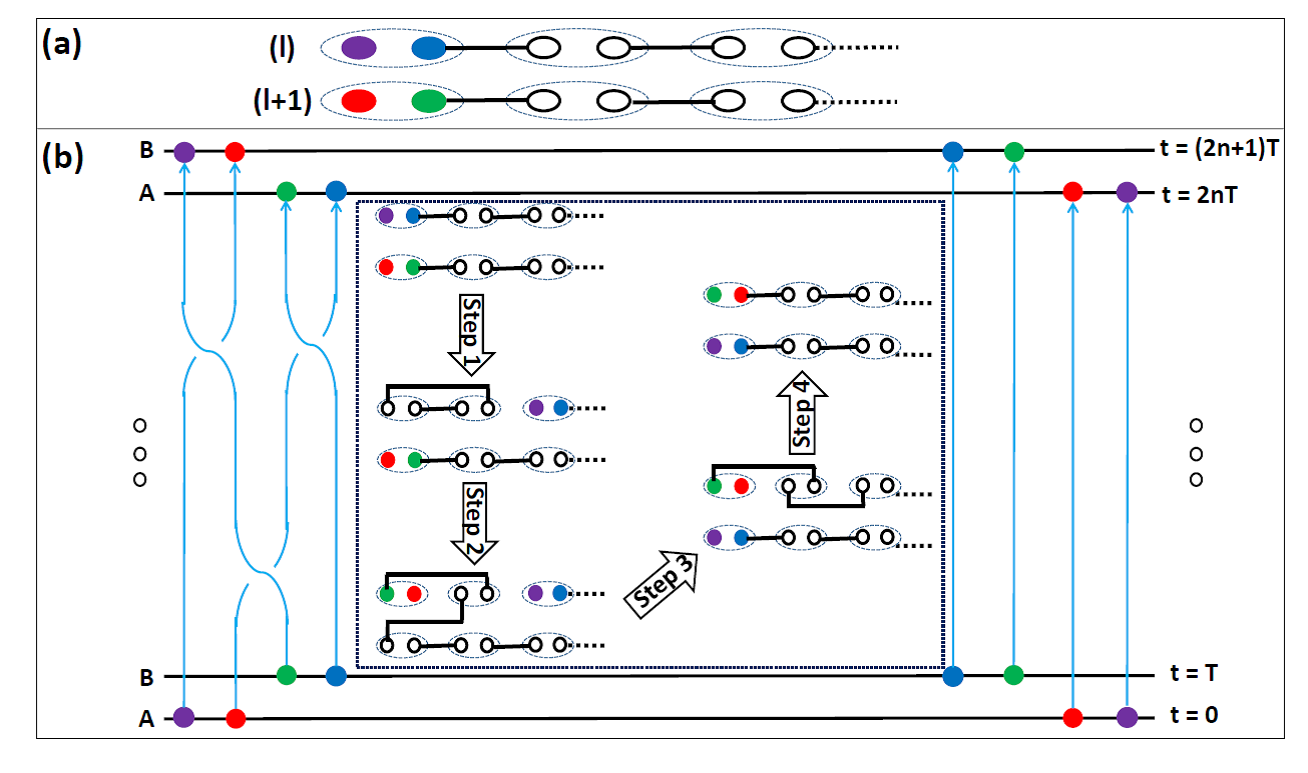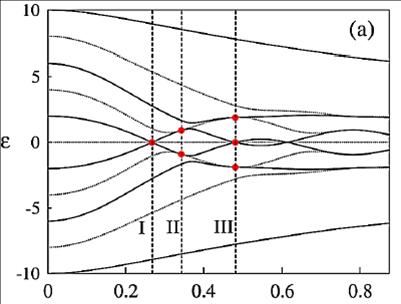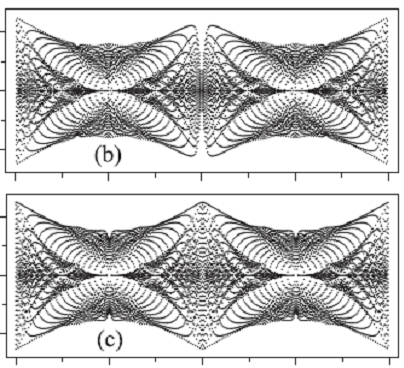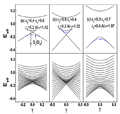|
RECENT HIGHLIGHTS
|
|
Research
News Updates:
Sep 2021:
In a new paper published in Nature Communications in Sep. 2021, Gong' group in collaboration with
Prof. Lee Ching Hua from NUS and Prof. Li Linhu at SYSU (Zhuhai) discovered how spectral winding topology on the complex energy plane
can be manifested by quantized classical response.
This is the first time that a quantized reponse is discovered in a purely classical setting.
For details, click here for the open access full paper.
Nov 2020:
A new lesson about phase transitions and criticality : As another timely contribution published in Nature Communications 2020,
Prof. Gong's group members in collaboration with Prof. Lee Ching Hua at NUS have discovered a theoretical behavior known as the "critical skin effect", influencing our thinking on how
changes between different phases of matter might occur. The main physics is described in a Phys.Org news article here
June 2020:
In a new publication in Physical Review Letters , Dr. Li Linhu and Prof. Gong in collaboration with Prof. Lee Ching Hua at NUS reported a topological switch
for observing non-Hermitian Skin effect in cold-atom systems with population loss. Unlike other studies that focus on how
the so-called skin effect affects topological studies, this work advocates to use topological localization to switch on or off the skin effect.
This published work is also featured in the Chinese news media InfoMat, with this link.
May 2020:
To make an atom-sized machine, you need a quantum mechanic : In a theory-experiment collaborative
work published in Nature Partner Journal: Quantum Information , a new progress in the story of the miniaturisation of machines is reported.
Prof. Gong and his experimental as well as theoretical collaborators have shown that a single atom can function as either an engine or a fridge.
Such a device could be engineered into future computers and fuel cells to control energy flows. This work is the main deliverable of Prof. Gong's MOE Tier-2 project
on the control and optimization of nanoscale heat engines. The details of this collaboration and the results
are featured in a Phys.Org news article at this link.
July 2019:
In a paper published in Physical Review Letters this month, Dr. Lee Ching Hua from IHPC at A*STAR and Dr. Li Linhu as well as Prof. Gong
reported the discovery of a novel hybrid higher-order skin-topological modes in nonreciprocal topological systems. This represents another exciting progress in ongoing extensive investigations of non-Hermitian topological matter.
In particular, while conventional higher-order phases are characterized by corner or hinge modes that arise due to the interesting interplay of topological localization mechanisms along two or more dimensions, this work introduced and constructed a novel
class of hybrid higher-order skin-topological boundary modes in nonreciprocal systems due to nonreciprocal pumping in one direction in addition to topological
localization in a second direction. It is unknown yet how to experimental realize this new mechanism in a realistic setup.
June 2019:
In two publications published in Physical Review Letters in June 2019 and in Nature Photonics in December 2018,
one quantum optics group led by Prof. Shangqing Gong in collaboration with Prof. Gong at NUS reported novel theoretical proposals as well as
their experimental realizations of nonreciprocal optical propagation based on the Doppler effect associated with hot atoms as well as the Electromagnetically-Induced-transparency (EIT) effect.
Of particular interest is a realization of nonreciprocal optical amplification, with forward power amplification of 26 dB and backward isolation of 30 dB,
the best performance reported so far. Nature Photonics also published a News & Views article to highlight this exciting progress
(see Nature Photonics, Vol. 12, 720-723, 2018).
July 2018:
In a paper published in Physical Review Letters , Dr. Li Linhu and Prof. Gong in collaboration with Dr. Lee Ching Hua from IHPC at A*STAR
reported novel types of Floquet semimetals, whose Floquet band-structure accomodate arbitralily many nodal loops, with exotic topological linkages between them.
The team further proposed to use both a Berry-phase related winding number and the Alexander polynomial topological invariant to characterize the fascinating
linkages among the nodal loops. This work thus presents a class of exotic Floquet topological phases that has hitherto not been proposed in any realistic setup.
Indeed, the group is continuing to investigate aspects of exotic Floquet topological matter.

June 2018:
The realization of large-scale quantum computing has been one of the most ambitious goals in physics and computer science.
However, as a real challenge, due to the lack of a self-error-correction mechanism in quantum mechanics, even the simplest algorithm must either
be accompanied by active error correction protocols and/or implemented with topologically protected systems.
In the latter case the robustness of the quantum gate operations can be partially guaranteed by the underlying topological properties
that will not change easily in the presence of some external noise.
Dr. Raditya Bomantara and Prof. Gong Jiangbin from NUS Physics Department have proposed a scalable scheme to implement quantum gate operations
by using a periodically driven quantum wire that can host two different species of topologically protected Majorana modes.
A shown in the paper published in Physical Review Letters , different species of
topologically protected Majorana excitations can be at the same edge of the quantum wire, but at different timings, namely, occupying different
sites in the time lattice. By exploiting this extra time-domain feature, a geometrical quantum gate that mimics the braiding of two or
even more Majorana quasi-particles can be realized. This quantum gate realization saves physical sources as compared with previous
quantum-wire based proposals. This realization of quantum gate operations is already relatively robust in the absence of any encoding
for error correction, thanks to the fact that the involved Majorana modes are protected by the underlying topological phases of the quantum wire.
This work thus offers stimulating ideas regarding a marriage between quantum computing and topological phases of matter via a new route towards
topologically protected quantum computing.

Mar. 2018:
Thousands of years ago the Archimedes screw emerged as a superb design to pump water into irrigation ditches.
It is believed to be of critical historical importance to the ancient world. On the physics side, in 1983 D.J. Thouless (Physics Nobel Laureate 2016)
proposed an elegant quantum pump, which directly connects topological invariants with quantized matter transport.
Thouless pump has opened up new applications of quantum physics and continues to influence fundamental research. In 2015
the Gong group discovered a coherence-induced correction to Thouless pump. Based on an experimental proposal designed by Gong
group, a collaborative study between NUS and Du Jiangfeng group from University of Science and Technology, China
finally confirmed the theory from Gong group via a publication in Physical Review Letters published in March 2018. In particular, the experiment implemented the Thouless pump that exploits
quantum coherence as a useful resource. Such a generalized Thouless pump is somewhat more reminiscent of the Archimedes screw,
because now the amount of pumped matter per cycle is no longer restricted by the underlying topological properties of the quantum system,
but becomes continuously tuneable and highly sensitive to quantum coherence features. As experimentally demonstrated, even the rate at which
the pump is switched on can be used to extensively control the amount of transported matter.
The experimental results have thus verified one new face of Thouless pump and may find innovative applications in coherence-based quantum control and
in the detection of topological phase transitions.

Oct. 2017:
Prof. Gong's team discovered a novel type of band structure featuring Dirac cones
that are robust to local perturbations without symmetry restrictions. Dirac-cone kind of band structure
has been a topic of great theoretical and experimental interest to studies to condensed-matter physics
(such as 2D materials like Graphene). Unlike a normal Dirac cone that can be
easily gapped by a mass term, the Dirac cones reported this time (published as a Rapid Communication in PRB) are protected by interactions treated on the mean-field level.
Even more remarkable, the Berry phase of the obtained Dirac cone is no longer quantized in Pi. Rather,
it can be continuously tuned as an order parameter, a result never seen before. Furthermore, in
an Aharonov-Bohm (AB) interference setup to detect such Dirac cones, the adiabatic AB phase is
found to be Pi both theoretically and computationally, offering an observable topological invariant
and a fascinating example where the Berry phase and adiabatic AB phase are fundamentally different.
The results not only expose a nonlinearity-induced quantum phase transition but also present new possibilities
of great interest to quantum physics itself.

Sep. 2017: Prof. Gong's group published
a series of findings regarding the celebrated Jarzynsky equality in both classical and quantum domains.
In three articles all published this year, Prof. Gong and his collaborators
uncovered that the convergence of a set of expermental data towards the classical Jarzynsky equality may undergo phase transitions and can become extremely slow
as compared with that suggested a central limit theorem. The situation in the quantum domain is even worse, in the sense that quantum fluctuations may
enhance the divergence of the second moment of an exponential form of the work, a key quantity in Jarzynski's relation. The results cast serious doubt
on possible experimental confirmation of quantum Jarzynski's equality and call for future studies of more useful quantum fluctuation theorems.
Feb.
2016: Our group member Raditya's first ever
research publication as a Ph.D student is highlighted in by Physical Review E as "Editor's Suggestion". The work describes fascinating features
of Floquet topological semimetal phases in a quantum chaos model.
Dec.
2015: In two publications published
in Physical Review B [PRB92, 245409, (2015) and PRB91, 085420,
(2015)], our group published a
highly original and pioneering finding regarding interband
coherence effects in Thouless's adiabatic
pumping. The results are expected to improve our understanding of the
dynamical aspects of topologically nontrivial systems.
Aug.
2015: Our Ph.D student Gaoyang and Dr. Gong published a series of papers in Physical Review E
regarding the control of work fluctuations and their implications for heat
engine designs. The most
original finding is a principle of minimal work fluctuations. That is, under quite general
conditions, an adiabatic process starting from an initial equilibrium state
will yield the least amount of work fluctuations [PRE92, 022130 (2015)] and
at the same time yield the minimal average work. This discovery is expected to have a
long-term impact on nanoscale heat engine designs.
Mar.
2013: In collaboration with our former group member Dr.
Zhang Qi as well as Prof. Oh from NUS physics department,
Dr. Gong's latest work (appeared in Physical
Review Letters of March 2013) reveals a novel aspect of
classical adiabatic processes. In particular, in adiabatic processes that invove the emergence of bifurcations, it is shown that
intrinsic dynamical fluctuations that are beyond the conventional adiabatic
theorem may play a decisive role in dynamically determining the outcome of
symmetry-breaking selections between symmetry-connected pathways of
adiabatic following. Detailed are here .
June
2012: Congratulations to our group member Derek Ho for his first-ever
research article published in the top Physics journal Physical
Review Letters .
In the PRL paper Derek and Dr. Gong studied how quantized acceleration might be
connected with Floquet band topology.
In both classical mechanics and quantum mechanics, position and momentum
variables can be treated on an equal footing from a phase space
perspective. However, the actual physical world does not have
position-momentum symmetry. For example, the energy band of a solid is
formed because the electronic Hamiltonian is periodic in position, but not
in momentum. Understandably then, we have much knowledge in quantum
transport in position space, but not much so in momentum space. Derek and Dr. Gong studied a class of non-relativistic quantum
systems periodically driven by instantaneous control pulses. The wide
spectrum of the control pulses induces a periodicity in momentum space.
Loosely speaking, this realizes a "momentum crystal". It is found
that the quantum mean acceleration is closely connected with the topology of
the so-called Floquet quasi-energy bands. By
adiabatically varying an experimentally tunable
parameter over one periodic cycle, they showed that the mean acceleration
of their model system prepared on momentum-space Wannier
states is quantized: it is proportional to the topological "Chern" integers of a Floquet
band. This finding shall stimulate more interests in momentum-space
transport as well as topological phase transitions in driven quantum
systems.
March
2012: Congratulations to our group member Qifang Zhao for his first-ever
research article published in Physical Review B, which is 14 pages long! In
the paper Qifang, CQT visiting professor Cord Muller and Dr. Gong studied localization behavior
of Dirac particles in disodered superlattices.
Feb
2012: The 17 February issue of Physical Review Letters
published two research articles by Dr. Gong,
both arising from successful collaborations with researchers from China.
One article reported quantum hyperdiffusion in tight-binding
lattices, whereas the other article studied some fundamental aspects of decoherence.
Jan
2012: Congratulations to our group member Adam Zaman Chaudhry for his
first-ever research article published in Physical Review A, which is 14
pages long! In the paper, Adam and Dr. Gong
proposed a universal scheme for the protection of two-qubit states and
two-qubit gates using several continuous-wave driving fields.
Oct
2011: Long-lasting exponential quantum behavior is discovered and explained by Dr. Gong and his collaborators
In the paper published in Physical
Review Letters ,
long-lasting exponential spreading of quantum states in momentum space will
be reported. Under what circumstances can we achieve exponential growth of
physical observables in a quantum system ? When
faced with such a question one often thinks of chaotic dynamics with
exponential sensitivity. However, in general exponential sensitivity cannot
directly give rise to exponential growth in physical observables because of
the complicated stretching and folding dynamics in phase space. To make
things worse, chaos is a classical-mechanics concept and it quickly loses
its meaning in a quantum system.
Dr. Gong and his collaborators (J. wang, I. Guarneri, and G. Casati)
from China and Italy show, for the first time, how long-lasting exponential
growth of momentum scale (or energy scale) can be possible in quantum
systems. First, the dynamics associated with a classical unstable fixed
point is exploited for exponential behavior.
Second, without pushing a quantum system closer to its true physical
classical limit, a small quantum system is tuned closed to a type of
quantum resonance, such that the dynamics of the close-to-resonance quantum
system behaves extremely close to a classical quasi-integrable
system with the desired unstable fixed point. The driving fields are
designed such that the initial quantum state can be placed almost exactly
on the stable manifold of an unstable fixed point and then as time evolves,
the quantum system displays long-lasting exponential behavior
that can involve a huge momentum scale. Because exponential behavior is fundamentally different from any polynomial
time-dependence, the possibility of having long-lasting exponential behavior in quantum systems reveals a previously
unknown quantum dynamical phenomenon. It not only stimulates the use of
near quantum-resonance dynamics in generating fascinating dynamical
phenomena in quantum systems, but also gives us a fresh starting point to
study what quantum coherence can do.
July
2011: First ever quantum simulation of a chemical
reaction process is successfully demonstrated
In a most recent article published in Physical
Review Letters , the first ever quantum simulation of a chemical
reaction process is demonstrated via an NMR platform. This is the second
collaboration between Dr. Gong and the USTC
experimental quantum information group led by Prof.
Jiangfeng Du. Quantum simulations are expected to
tremendously change the way we explore condensed-matter physics and quantum
chemistry. The reported experiment realized a useful map from laser-driven
chemical reaction dynamics to the dynamics of interacting spin systems
under shaped radio-frequency fields.
Apr.
2011: Dr.
Gong won the NUS Young Researcher Award
Feb.
2011: First experimental demonstration of
entanglement protection in solids using dynamical decoupling is realized
In a recent Physical Review Letters paper collaboratively
done by Dr. Gong and a USTC experimental group
led by Prof. Jiangfeng
Du, it is demonstrated experimentally that dynamical decoupling can well
protect pseudoentanglement of a two-spin system,
with the lifetime of pseudoentangled states
extended from 0.4 microseconds to 30 microseconds by a two-flip dynamical
decoupling sequence operated on one spin only. The experimental results
also suggest the need to apply dynamical decoupling sequences to both spins
in order to preserve entanglement longer.
Nov.
2010: Protecting unknown entangled states with
unknown system-bath coupling is possible, at least in theory
In a recent paper in Phys. Rev. A, Musawwadah Mukhtar, Wee Tee Soh, Thuan
Beng Saw, and Dr. Gong
extended their earlier work and presented a strategy that can be used to
protect unknown two-qubit entangled states with unknown system-bath
coupling via either nonlocal or local control operators.
Jan.
2010: How to keep your entangled states fresh
Quantum entanglement, dubbed "spooky action at a distance" by
Einstein, is probably the most strange aspect of
quantum physics. Quantum entanglement is now being exploited for
applications in many fields, including quantum teleportation, quantum
cryptography, quantum computation etc. However, quantum entanglement is
very fragile and it often vanishes within no time due to system-bath
coupling. So how to actively keep an entangled state is an issue of vast
importance and significance, especially when physicists have no control or
knowledge of the environment. As a major extension of previous studies of
quantum state protection for a single quantum bit, Musawwadah
Mukhtar, Thuan Beng
Saw, Wee Tee Soh, and Dr. Gong
demonstrate, both mathematically and conceptually, how to freeze and hence
store a known entangled state of two quantum bits without deterioation, in an efficient and universal fashion.
This work, to appear in Phys. Rev. A soon, also paves an exciting avenue
for future work on preserving unknown entangled states.
Sep.
2009:

Dr. Gong and his collaborators Dr. Luis Moracles-Molina and
NUS visiting professor Peter Hanggi discovered a novel
type of coherent destruction of tunneling. They
introduced a new scenario of quantum manipulation by considering a
monochromatic fast modulation of the self-interaction strength of a
many-boson system, which is feasible by Feshbach
resonance management in ultracold systems.
Dramatically, they showed that this self-interaction-strength modulation
can be tuned such that only an arbitrarily prescribed number of particles
are allowed to tunnel in a double well potential. The associated tunneling dynamics is also sensitive to the odd or even
nature of the number of bosons. The results, already accepted for
publication in Physical Review Letters , will motivate
great interests in quantum control of many-body systems.
May
2009:

Dr Gong and his collaborator Dr. Jiao Wang
discovered a novel type of butterfly Floquet
spectrum in driven quantum systems with an SU(2)
dynamical algebra. Their findings, to be published in Physical
Review Letters soon, are relevant to studies of fractal
spectral statistics, quantum chaos, quantum phase transitions, and non-mean-field
effects in Bose-Einstein condensates.
Oct.
2008: Dr. Gong won the "Young Scientist
Award" from the Faculty of Science, National Univ. of Singapore.
Aug.
2008:

As a remarkable and fruitful collaboration between mathematicians and physicists,
Prof. Wayne Lawton from NUS Mathematics
Department and our group established (Lawton, Mouritzen,
Wang, and Gong, submitted to J. Math. Phys.) that
the butterfly spectrum of our earlier cold-atom-in-kicking-optical-lattice
model is identical with that of a celebrated paradigm of quantum chaos,
when and only when the effective Planck constant is an irrational number.
The strict proof is based on the so-called rotation C*-algebra. Results
will motivate new interests in the mathemetical
aspects of quantum dynamics.
June
2008:
 
In collaboration with Prof. Peter Hanggi from Univ. of Augsberg,
two related studies from Dr. Gong's group on
controlling nonlinear Landau-Zener processes are published by Physical
Review A and New Journal of Physics . The published
results are hoped to be very useful for better control of many-body quantum
systems.
Apr.
2008: Dr. Gong's invited book review on
"Introduction to Quantum Control and Dynamics" by Dr. D. D'Alessandro is published in the International
Journal of Quantum Information.
Jan.
2008:

Dr. Gong and his collaborators from Germany and
USA put forward a new and simple approach to realizing coherent and
directed transport of cold atoms. Their work will appear in Physical
Review Letters very soon.
Jan.
2008: Congratulations to our graduate student Ms. Vinitha
Balachandran for her first ever research publication, published in the
first issue of this year's Physical Review A (Vol. 77, 012303, 2008). The
title of the work is "Adiabatic Quantum Transport in a Spin Chain with
a Moving Potential".
Nov.
2007:

In collaboration with Dr. Jiao Wang from Tamesak Laboratories at NUS, we have discovered a
direct connection between two most important paradigms of quantum and classical
chaos, namely, the kicked-rotor model and the kicked Harper model. We have
also suggested how to experimentally realize the found connection using
cold atoms in pulsed optical lattices. Previously, these two models were
regarded as two entirely different systems. As stressed in a paper accepted
by the Rapid Communication section of
Physical Review A (see also ArXiv 0711.3939), a
new generation of cold atom experiments may be motivated.
Dec.
2006:

In a paper appearing in Physical Review Letters this
month, Dr. Gong and his collaborator Prof. Brumer described an
intriguing quantum coherence phenomenon in classically chaotic systems,
called "quantum ratchet accelerator with full classical chaos".
This work clearly indicates that quantum coherence can be used to
dramatically enhance the directed transport in chaotic systems.
|
|